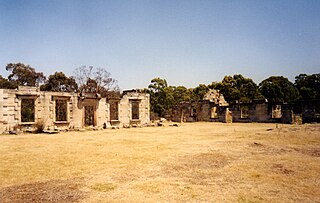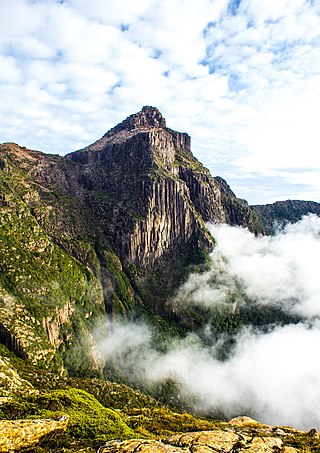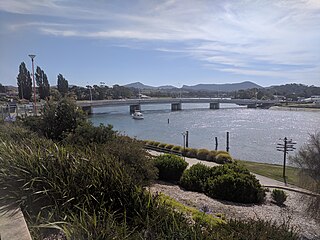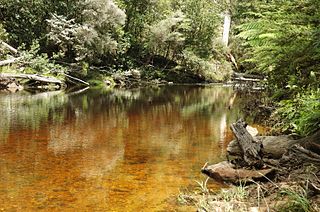The Walls of Jerusalem National Park is a national park located in the Central Highlands region of Tasmania, Australia. The park is located approximately 144 km (89 mi) northwest of Hobart, east of the Cradle Mountain-Lake St Clair National Park, and west of the Central Plateau Conservation Area. It is south of Mole Creek, Tasmania, and Rowallan Lake. The national park forms part of the Tasmanian Wilderness World Heritage Area.

Lake St Clair or leeawulenna is a natural freshwater lake located in the Central Highlands area of Tasmania, Australia. The lake forms the southern end of the Cradle Mountain-Lake St Clair National Park. It has an area of approximately 45 square kilometres (17 sq mi), and a maximum depth of 215 metres (705 ft), making it Australia's deepest lake.

Saltwater River is a rural locality in the local government area (LGA) of Tasman in the South-east LGA region of Tasmania. The locality is about 14 kilometres (8.7 mi) north of the town of Nubeena. The 2016 census has a population of 123 for the state suburb of Saltwater River.

Mount Roland is a locality, a mountain, and a conservation area in the north west coast region of Tasmania, Australia.
Guildford is a rural locality in the local government area (LGA) of Waratah–Wynyard in the North-west and west LGA region of Tasmania. The locality is about 81 kilometres (50 mi) south of the town of Wynyard. The 2016 census has a population of nil for the state suburb of Guildford.

South West Tasmania is a region in Tasmania that has evoked curiosity and wonder during the period of European presence on the island.
Kellevie is a rural locality in the local government area (LGA) of Sorell in the South-east LGA region of Tasmania. The locality is about 28 kilometres (17 mi) east of the town of Sorell. The 2016 census has a population of 164 for the state suburb of Kellevie.
Mountain River is a rural locality in the local government area (LGA) of Huon Valley in the South-east LGA region of Tasmania. The locality is about 15 kilometres (9.3 mi) north-east of the town of Huonville. The 2016 census recorded a population of 559 for the state suburb of Mountain River. The locality increasingly is a lifestyle destination, being only about 30 minutes south of the Tasmanian capital Hobart by road.
Stony Rise is a rural residential locality in the local government area (LGA) of Devonport in the North-west and west LGA region of Tasmania, Australia. The locality is about 4 kilometres (2.5 mi) south of the town of Devonport. The 2021 census recorded a population of 728 for the state suburb of Stony Rise. It is primarily a residential suburb of Devonport.
Tugrah is a rural locality in the local government area (LGA) of Devonport in the North-west and west LGA region of Tasmania. The locality is about 4 kilometres (2.5 mi) south-west of the town of Devonport. The 2021 census recorded a population of 470 for the state suburb of Tugrah. It is a suburb of Devonport, Tasmania, located on the south western side of the city.

South Burnie is a locality and suburb of Burnie in the local government area of City of Burnie, in the North West region of Tasmania. It is located about 2.5 kilometres (1.6 mi) south-east of the town of Burnie. The Bass Highway passes from south-east to north-west along the shore of Bass Strait, which forms part of the northern boundary. The Emu River forms part of the eastern boundary. The 2016 census determined a population of 331 for the state suburb of South Burnie.
Emu Heights is a locality and suburb of Burnie in the local government area of City of Burnie, in the North West region of Tasmania. It is located about 3.8 kilometres (2.4 mi) south-east of the town of Burnie. The Emu River forms the eastern boundary, and the railway tracks of the Melba line form most of the western. The 2016 census determined a population of 180 for the state suburb of Emu Heights.
Gawler is a locality and small rural community in the local government area of Central Coast, in the North West region of Tasmania. It is located about 8 kilometres (5.0 mi) south of the town of Ulverstone. The 2021 census determined a population of 703 for the state suburb of Gawler.
Black River is a locality and small rural community in the local government area of Circular Head, in the North West region of Tasmania. It is located about 46 kilometres (29 mi) north-west of the town of Wynyard. Bass Strait forms most of the northern boundary, while the stream named “Black River” forms the western boundary. The 2016 census determined a population of 35 for the state suburb of Black River.
Irishtown is a locality and small rural community in the local government area of Circular Head, in the North West region of Tasmania. It is located about 8 kilometres (5.0 mi) south-east of the town of Smithton. The 2016 census determined a population of 301 for the state suburb of Irishtown.

The River Leven is a perennial river for most of its length, located in the north-western region of Tasmania, Australia. It was named by the Van Diemen's Land Company after the River Leven in Scotland.

The Emu River is a perennial river for most of its length, located in the north-western region of Tasmania, Australia. It was named by Henry Hellyer, an early explorer who saw emu tracks in the vicinity.
The Black River is a perennial river for most of its length, located in the north-western region of Tasmania, Australia.
Lower Barrington is a locality and small rural community in the local government area of Kentish in the North West region of Tasmania. It is located about 16 kilometres (9.9 mi) south-west of the town of Devonport. The 2016 census determined a population of 238 for the state suburb of Lower Barrington.
West Kentish is a locality and small rural community in the local government area of Kentish in the North West region of Tasmania. It is located about 29 kilometres (18 mi) south-west of the town of Devonport. The 2016 census determined a population of 165 for the state suburb of West Kentish.







